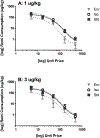Effects of environmental enrichment on self-administration of the short-acting opioid remifentanil in male rats
- PMID: 28916995
- PMCID: PMC6541008
- DOI: 10.1007/s00213-017-4734-2
Effects of environmental enrichment on self-administration of the short-acting opioid remifentanil in male rats
Abstract
Background: Opioid abuse is a major problem around the world. Identifying environmental factors that contribute to opioid abuse and addiction is necessary for decreasing this epidemic. In rodents, environmental enrichment protects against the development of low dose stimulant self-administration, but studies examining the effect of enrichment and isolation (compared to standard housing) on the development of intravenous opioid self-administration have not been conducted. The present study investigated the role of environmental enrichment on self-administration of the short-acting μ-opioid remifentanil.
Methods: Rats were raised in an enriched condition (Enr), standard condition (Std), or isolated condition (Iso) beginning at 21 days of age and were trained to lever press for 1 or 3 μg/kg/infusion remifentanil in young adulthood. Acquisition of self-administration and responding during increasing fixed ratio requirements were assessed, and a dose-response curve was generated.
Results: In all phases, Enr rats lever pressed significantly less than Std and Iso rats, with Enr rats pressing between 9 and 40% the amount of Iso rats. Enr rats did not acquire remifentanil self-administration when trained with 1 μg/kg/infusion, did not increase responding over increasing FR when trained at either dose, and their dose-response curves were flattened compared to Std and Iso rats. When expressed as economic demand curves, Enr rats displayed a decrease in both essential value (higher α) and reinforcer intensity (Q 0) compared to Std and Iso rats at the 1 μg/kg/infusion training dose.
Conclusion: Environmental enrichment reduced remifentanil intake, suggesting that social and environmental novelty may protect against opioid abuse.
Keywords: Environmental enrichment; Opioid; Remifentanil; Self-administration; Social isolation.
Figures





Similar articles
-
Effect of delay on self-administration of remifentanil under a drug versus drug choice procedure in rhesus monkeys.J Pharmacol Exp Ther. 2013 Dec;347(3):557-63. doi: 10.1124/jpet.113.208355. Epub 2013 Sep 16. J Pharmacol Exp Ther. 2013. PMID: 24042159 Free PMC article.
-
Morphine deprivation increases self-administration of the fast- and short-acting mu-opioid receptor agonist remifentanil in the rat.J Pharmacol Exp Ther. 2008 Sep;326(3):920-9. doi: 10.1124/jpet.108.139196. Epub 2008 May 30. J Pharmacol Exp Ther. 2008. PMID: 18515643 Free PMC article.
-
Self-administration of remifentanil, an ultra-short acting opioid, under continuous and progressive-ratio schedules of reinforcement in rats.Psychopharmacology (Berl). 2000 May;150(1):61-6. doi: 10.1007/s002130000415. Psychopharmacology (Berl). 2000. PMID: 10867977
-
Interactions between opioids and cannabinoids: Economic demand for opioid/cannabinoid mixtures.Drug Alcohol Depend. 2020 Jul 1;212:108043. doi: 10.1016/j.drugalcdep.2020.108043. Epub 2020 May 12. Drug Alcohol Depend. 2020. PMID: 32497977 Free PMC article.
-
The pharmacokinetics of remifentanil.J Clin Anesth. 1996 Dec;8(8):679-82. doi: 10.1016/s0952-8180(96)00179-1. J Clin Anesth. 1996. PMID: 8982900 Review.
Cited by
-
Effects of NMDA receptor antagonists on behavioral economic indices of cocaine self-administration.Drug Alcohol Depend. 2022 Apr 1;233:109348. doi: 10.1016/j.drugalcdep.2022.109348. Epub 2022 Feb 12. Drug Alcohol Depend. 2022. PMID: 35176632 Free PMC article.
-
Effect of the glucocorticoid receptor antagonist PT150 on acquisition and escalation of fentanyl self-administration following early-life stress.Exp Clin Psychopharmacol. 2023 Apr;31(2):362-369. doi: 10.1037/pha0000577. Epub 2022 May 19. Exp Clin Psychopharmacol. 2023. PMID: 35587421 Free PMC article.
-
Enhancing translation: A need to leverage complex preclinical models of addictive drugs to accelerate substance use treatment options.Pharmacol Biochem Behav. 2024 Oct;243:173836. doi: 10.1016/j.pbb.2024.173836. Epub 2024 Jul 26. Pharmacol Biochem Behav. 2024. PMID: 39067531 Review.
-
Effects of the glucocorticoid receptor antagonist PT150 on stress-induced fentanyl seeking in male and female rats.Psychopharmacology (Berl). 2021 Sep;238(9):2439-2447. doi: 10.1007/s00213-021-05865-0. Epub 2021 May 18. Psychopharmacology (Berl). 2021. PMID: 34008048 Free PMC article.
-
Therapeutic efficacy of environmental enrichment for substance use disorders.Pharmacol Biochem Behav. 2020 Jan;188:172829. doi: 10.1016/j.pbb.2019.172829. Epub 2019 Nov 26. Pharmacol Biochem Behav. 2020. PMID: 31778722 Free PMC article. Review.
References
-
- Alexander BK, Coambs RB, Hadaway PF (1978) The effect of housing and gender on morphine self-administration in rats. Psychopharmacology (Berl) 58: 175–179. - PubMed
-
- Baker L, Ratka A (2002) Sex-specific differences in levels of morphine, morphine-3-glucuronide, and morphine antinociception in rats. Pain 95: 65–74. - PubMed
-
- Bardo MT, Klebaur JE, Valone JM, Deaton C (2001) Environmental enrichment decreases intravenous self-administration of amphetamine in female and male rats. Psychopharmacology 155: 278. - PubMed
-
- Barnett NP, Ott MQ, Rogers ML, Loxley M, Linkletter C, Clark MA (2014) Peer associations for substance use and exercise in a college student social network. Health psychology : official journal of the Division of Health Psychology, American Psychological Association 33: 1134–42. - PubMed
MeSH terms
Substances
Grants and funding
LinkOut - more resources
Full Text Sources
Other Literature Sources
Medical
Research Materials

